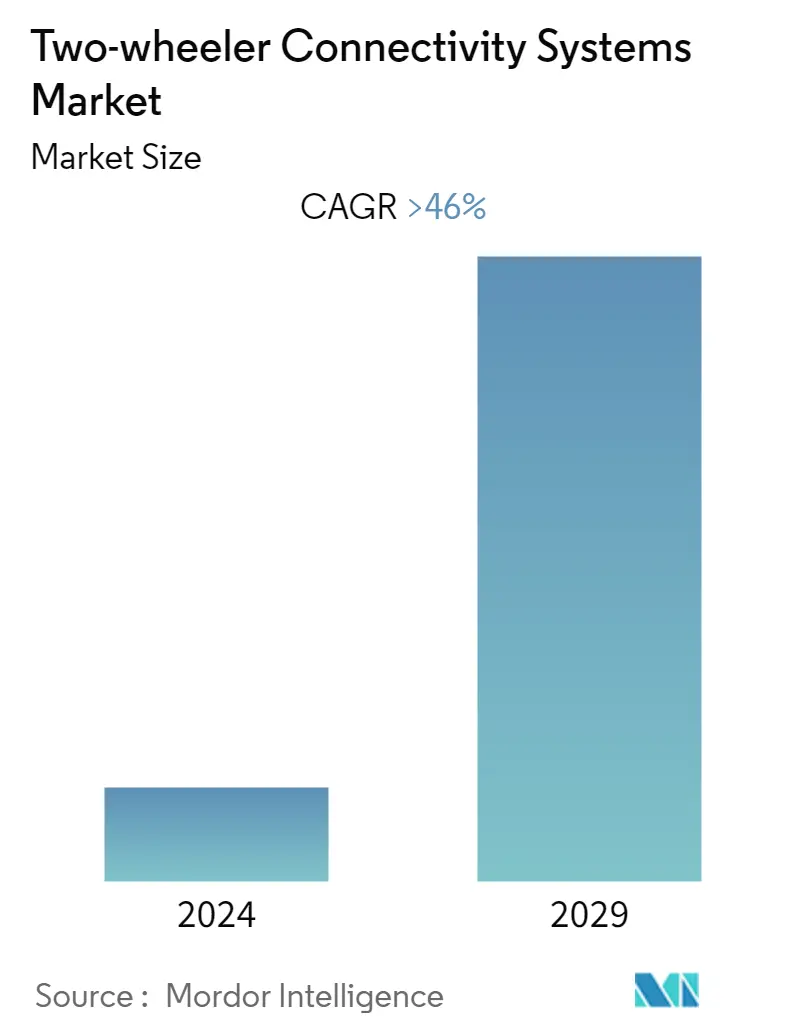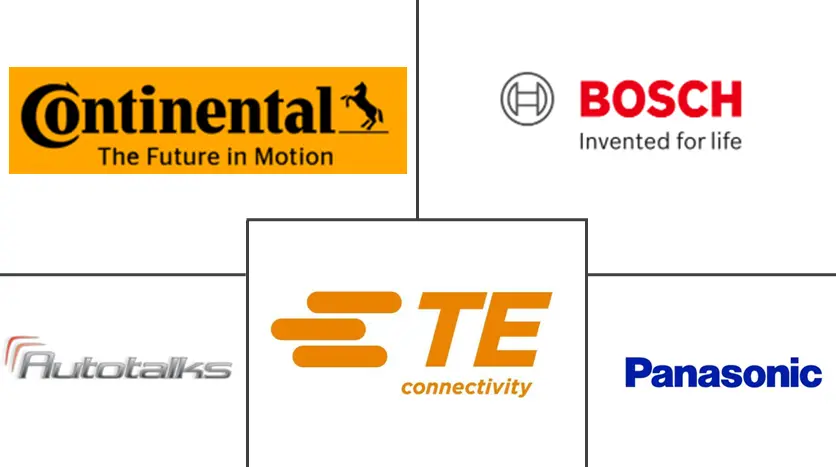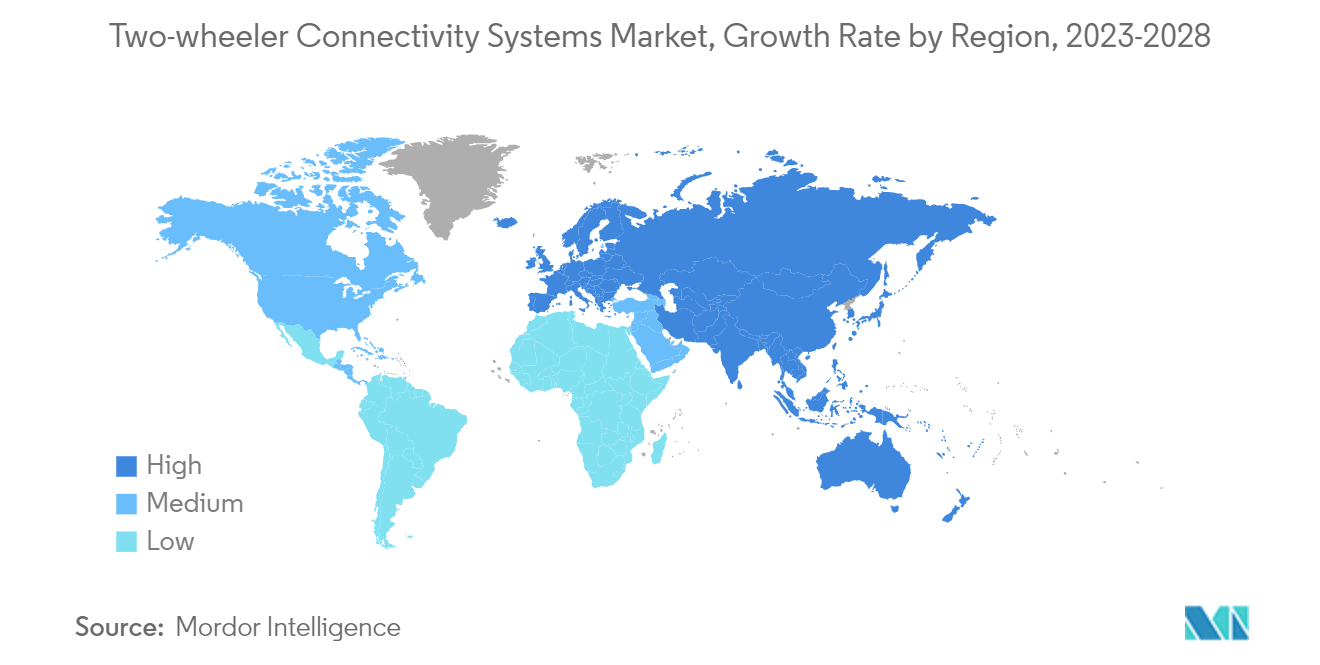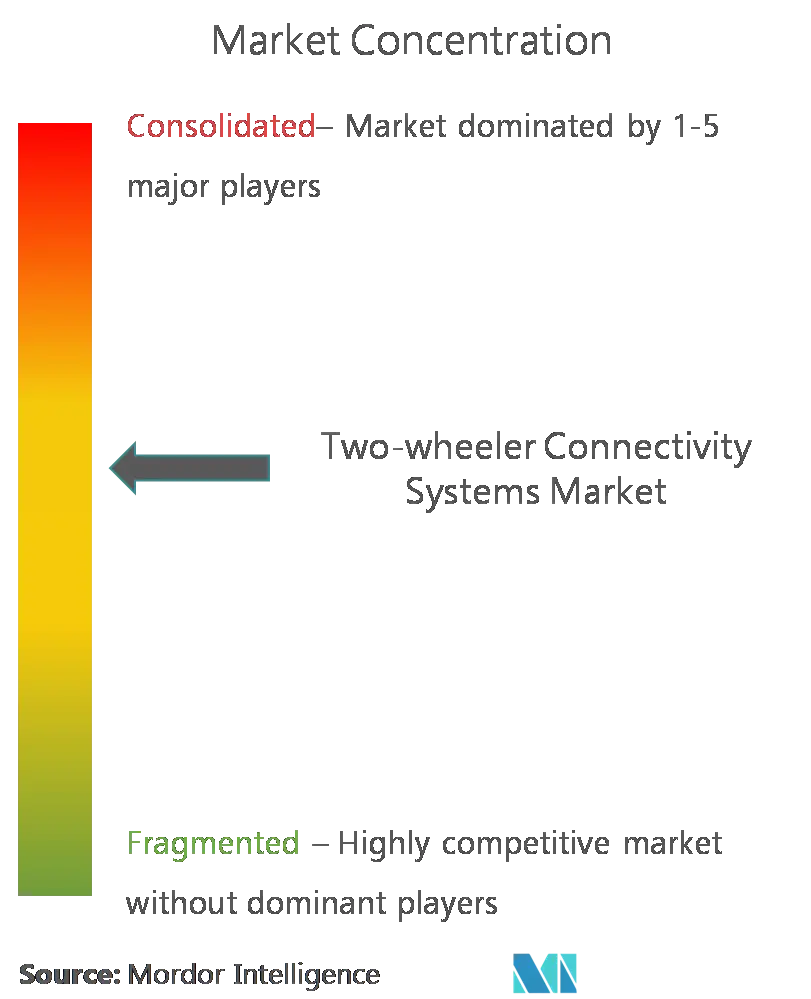Two-Wheeler Connectivity Systems Market Size

| Study Period | 2019 - 2029 |
| Base Year For Estimation | 2023 |
| CAGR | 46.00 % |
| Fastest Growing Market | Asia-Pacific |
| Largest Market | Europe |
| Market Concentration | Medium |
Major Players
*Disclaimer: Major Players sorted in no particular order |
Two-Wheeler Connectivity Systems Market Analysis
The two-wheeler connectivity systems market was valued at USD 187.86 million, and it is expected to reach USD 1.87 billion during the forecast period, registering a CAGR of above 46%.
- The COVID-19 pandemic hindered the growth of the two-wheeler market due to shutdowns of manufacturing units and travel restrictions. In addition, with virtually no activity in tourism, the aftermarket segment of the connectivity systems in the two-wheeler market also witnessed a slowdown. As the market gains momentum, it is expected to witness positive growth over the forecast period.
- Smart connection systems provide a better experience and greater safety measures for commuters. Due to linked system solutions, riders will have access to digital information and entertainment while riding their two-wheelers. The rise of linked two-wheelers is expected to create possibilities for connected motorcycles and app developers. Market companies must improve existing applications and develop two-wheeler-specific apps. After the advent of electric motorbikes, the market for two-wheeler connection systems has seen tremendous expansion. The necessity of knowing vital facts such as battery state, driving range, and so on is a major factor in developing electric two-wheeler networking systems.
- Factors like technology advancements, advancements in vehicle safety, the introduction of driver-assist systems in motorcycles, and rapidly growing logistics in the retail and e-commerce sectors have been significantly driving demand for the connected motorcycle market.
- Increasing internet penetration and improvements in Internet connectivity and speed 5G to support vehicle-to-vehicle and vehicle-to-infrastructure, along with the increase in demand for features, like driving assistance systems, real-time safety, navigation, and GPS monitoring, are expected to contribute to market growth.
Two-Wheeler Connectivity Systems Market Trends
Sale of Electric Two-wheelers Poised to Boost Market Growth
- The demand for electric motorcycles is growing around the world. As technological advancements in electric motorcycles are increasing, and the market is witnessing the entry of new players, demand will continue to grow over the years to come.
- Concerns over emissions, increasing consumer awareness, and increasing investments by government authorities to develop electric vehicle charging infrastructure are expected to propel the demand for electric motorcycles.
- With the growing demand for electric motorcycles, many new players have gained a significant market share over the past few years, and existing conventional motorcycle manufacturers are also trying to enter this market. For instance,
- Zero's current product portfolio includes FX, a small on- and off-road capable 'dual-sport' motorcycle starting at USD 9,300, and the SR/S sports bike starting at USD 20,000. The SR/S bike can reach 124 miles per hour and has a range of about 200 miles when equipped with an enhanced battery. Zero offers its motorcycles an app that lets users modify the bikes' various performance parameters, like maximum speed, power, torque, and regenerative braking.
- India is one of the major two-wheeler markets in the world. For the past few years, the country has attracted various global players and several new startups into the market with the launch of new electric motorcycles. Moreover, this trend will continue as many new players have announced new product launches.
- Such factors are likely to drive the demand over the coming years.

Europe Expected to Lead the Market
- Europe is anticipated to hold the major share in the two-wheeler connectivity systems market over the forecast period. A total of 950,400 motorcycles were registered in the main European markets in 2022, compared to 949,480 units in 2021.
- Germany, France, and Italy are witnessing an increasing number of startups and established conventional motorcycle manufacturers launching new two-wheeler connectivity systems in the market. For instance,
- Bosch's rider assistance systems provide adaptive cruise control, forward collision systems, and blind-spot detection. Bosch claims that these systems can prevent one in seven accidents. This technology of Bosch will be adopted in bikes ranging from Ducati and KTM. Bosch is also developing connectivity systems that will alert two-wheelers on the network about the speed and position of other vehicles. This system would be very useful during low visibility situations and blind corners. In case of an accident, an emergency call feature will automatically notify emergency services with the GPS coordinates of the bike.
- Audi and Ducati jointly showcased C-V2X technology as part of the Ducati 2025 roadmap. The technology performs intersection collision warnings, cross-traffic turn collision risk warnings, and warning in case of sudden braking of the vehicle ahead.

Two-Wheeler Connectivity Systems Industry Overview
The two-wheeler connectivity systems market is not dominated by a handful of players, but it is marked by several new startups and established players. Bosch, one of the market leaders, has an integrated connectivity cluster that is a rider information system and connects motorcycles and smartphones. It is used to operate apps, and its connectivity control unit connects motorcycles to the cloud. Manufacturers are showing their presence in this new market, which earlier was dominated by startups, tech companies, and suppliers.
In January 2022, a Chinese motorcycle maker introduced the Shengshi GK350, which is a Chinese rival of the CB300r. The instrument cluster is a Bluetooth-enabled LCD display that supports navigation.
Two-Wheeler Connectivity Systems Market Leaders
-
Robert Bosch GmbH
-
Continental AG
-
TE Connectivity
-
Panasonic Corporation
-
Autotalks LTD
*Disclaimer: Major Players sorted in no particular order

Two-Wheeler Connectivity Systems Market News
October 2022: Continental announced that they are developing a hardware and software platform that is expected to enable connectivity in motorcycles and can run without a smartphone.
February 2022: Bosch India announced that it is working on low-cost advanced driver assistant systems (ADAS) Tech. The focus is on two- and three-wheelers since they are light and well-suited for electric mobility.
Two-Wheeler Connectivity Systems Market Report - Table of Contents
1. INTRODUCTION
- 1.1 Study Assumptions
- 1.2 Scope of the Study
2. RESEARCH METHODOLOGY
3. EXECUTIVE SUMMARY
4. MARKET DYNAMICS
-
4.1 Market Drivers
- 4.1.1 Sale of Electric Two-wheelers Poised to Boost Market Growth
-
4.2 Market Restraints
- 4.2.1 Lack of Connectivity Infrastructure
-
4.3 Industry Attractiveness - Porter's Five Forces Analysis
- 4.3.1 Threat of New Entrants
- 4.3.2 Bargaining Power of Buyers/Consumers
- 4.3.3 Bargaining Power of Suppliers
- 4.3.4 Threat of Substitute Products
- 4.3.5 Intensity of Competitive Rivalry
5. MARKET SEGMENTATION (Value in USD)
-
5.1 By Feature Type
- 5.1.1 Driver Assistance
- 5.1.2 Safety
- 5.1.3 Vehicle Management
- 5.1.4 Infotainment
- 5.1.5 Other Features
-
5.2 By Powertrain Type
- 5.2.1 Internal Combustion Engine
- 5.2.2 Electric
-
5.3 By Network Type
- 5.3.1 Vehicle-to-everything (V2X)
- 5.3.2 Dedicated short-range communication (DSRC)
-
5.4 By Geography
- 5.4.1 North America
- 5.4.1.1 United States
- 5.4.1.2 Canada
- 5.4.1.3 Rest of North America
- 5.4.2 Europe
- 5.4.2.1 Germany
- 5.4.2.2 United Kingdom
- 5.4.2.3 France
- 5.4.2.4 Rest of Europe
- 5.4.3 Asia-Pacific
- 5.4.3.1 India
- 5.4.3.2 China
- 5.4.3.3 Japan
- 5.4.3.4 South Korea
- 5.4.3.5 Rest of Asia-Pacific
- 5.4.4 Rest of the World
- 5.4.4.1 Brazil
- 5.4.4.2 South Africa
- 5.4.4.3 United Arab Emirates
- 5.4.4.4 Other Countries
6. COMPETITIVE LANDSCAPE
- 6.1 Vendor Market Share
-
6.2 Company Profiles*
- 6.2.1 Robert Bosch GmbH
- 6.2.2 Continental AG
- 6.2.3 Starcom Systems Ltd
- 6.2.4 BMW Group
- 6.2.5 TE Connectivity
- 6.2.6 KPIT Technologies Limited
- 6.2.7 Autotalks Ltd
- 6.2.8 Panasonic Corporation
- 6.2.9 Aeris Communications
- 6.2.10 Fabricacion Componentes Motocicletas SA
7. MARKET OPPORTUNITIES AND FUTURE TRENDS
** Subject To AvailablityTwo-Wheeler Connectivity Systems Industry Segmentation
The two-wheeler connectivity systems are technologies that allow motorcycles and scooters to communicate with other devices, such as smartphones or other vehicles, to provide riders with useful information and features.
The two-wheeler connectivity systems market is segmented by feature type, powertrain type, network type, and geography. By feature type, the market is segmented into driver assistance, safety, vehicle management, infotainment, and other features. By powertrain type, the market is segmented into ICE and electric. By network type, the market is segmented into Vehicle-to-everything (V2X) and Dedicated short-range communication (DSRC). By geography, the market is segmented into North America, Europe, Asia-Pacific, and Rest of the World.
The report offers market size and forecast in value (in USD) for all the above segments.
| By Feature Type | Driver Assistance | |
| Safety | ||
| Vehicle Management | ||
| Infotainment | ||
| Other Features | ||
| By Powertrain Type | Internal Combustion Engine | |
| Electric | ||
| By Network Type | Vehicle-to-everything (V2X) | |
| Dedicated short-range communication (DSRC) | ||
| By Geography | North America | United States |
| Canada | ||
| Rest of North America | ||
| By Geography | Europe | Germany |
| United Kingdom | ||
| France | ||
| Rest of Europe | ||
| By Geography | Asia-Pacific | India |
| China | ||
| Japan | ||
| South Korea | ||
| Rest of Asia-Pacific | ||
| By Geography | Rest of the World | Brazil |
| South Africa | ||
| United Arab Emirates | ||
| Other Countries |
Two-Wheeler Connectivity Systems Market Research FAQs
What is the current Two-wheeler Connectivity Systems Market size?
The Two-wheeler Connectivity Systems Market is projected to register a CAGR of greater than 46% during the forecast period (2024-2029)
Who are the key players in Two-wheeler Connectivity Systems Market?
Robert Bosch GmbH , Continental AG , TE Connectivity , Panasonic Corporation and Autotalks LTD are the major companies operating in the Two-wheeler Connectivity Systems Market.
Which is the fastest growing region in Two-wheeler Connectivity Systems Market?
Asia-Pacific is estimated to grow at the highest CAGR over the forecast period (2024-2029).
Which region has the biggest share in Two-wheeler Connectivity Systems Market?
In 2024, the Europe accounts for the largest market share in Two-wheeler Connectivity Systems Market.
What years does this Two-wheeler Connectivity Systems Market cover?
The report covers the Two-wheeler Connectivity Systems Market historical market size for years: 2019, 2020, 2021, 2022 and 2023. The report also forecasts the Two-wheeler Connectivity Systems Market size for years: 2024, 2025, 2026, 2027, 2028 and 2029.
Two-Wheeler Connectivity Systems Industry Report
The Global Two-Wheeler Connectivity Systems Market report provides a comprehensive industry analysis, focusing on various feature types including driver assistance, safety, vehicle management, infotainment, and other features. The market is segmented by powertrain types such as ICE and Electric, as well as network types like Vehicle-to-Everything (V2X) and Dedicated Short-Range Communication (DSRC). The report covers geographical regions including North America, Europe, Asia-Pacific, and the Rest of the World, offering a detailed market forecast and market overview.
The industry research highlights the market growth and market trends, emphasizing the importance of connectivity systems in enhancing the overall riding experience and safety of two-wheelers. The report includes a market review and market segmentation, providing insights into market leaders and their strategies. It also discusses the industry outlook and market predictions, projecting significant growth in the coming years.
Additionally, the report includes industry statistics and market data, offering a thorough market analysis and market value assessment. The market is expected to witness substantial growth, driven by advancements in technology and increasing consumer demand for connected vehicles. The industry size and industry sales are also analyzed, providing a clear picture of the market dynamics.
For those interested in a more detailed understanding, the report example and report pdf are available for download, offering an in-depth look at the market research and industry information. The report is an essential resource for research companies and stakeholders looking to stay ahead of market trends and capitalize on emerging opportunities.



